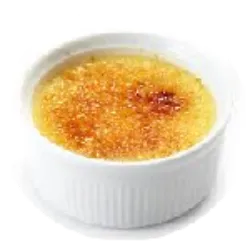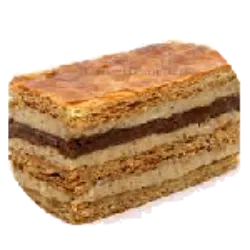Chocolate mousse

Chocolate mousse, created in the early 20th century by Henri de Toulouse-Lautrec, is a classic French dessert composed mainly of chocolate and beaten egg whites. Versatile in its preparation, it can be enriched with egg yolks, sugar, gelatin and spices, offering a delicious experience in renowned restaurants.
The history of Crème Brûlée dates back to the 17th century

The history of Crème Brûlée dates back to the 17th century. The first known reference to this dessert was found in the book "Nouveau cuisinier royal et bourgeois", written by François Massialot and published in 1691. The term "brûlée" in French means "toasted" or "burnt". Crème Brûlée is a dessert made with cream, eggs, sugar and vanilla, with a sugar crust burned by a blowtorch. It was immortalized in popular culture, gaining prominence in films and literary works. For example, in the film "The Fabulous Destiny of Amélie Poulain," the dessert is mentioned in a memorable scene, contributing to its global notoriety.
Test yourself with one of these challenges 👇
Discover some interesting facts about French Cuisine
Mille-feuille, originating in France in 1651 by François Pierre de La Varenne

Mille-feuille, originating in France in 1651 by François Pierre de La Varenne, gained notoriety in 1867 when confectioner Adolphe Seugnot opened a store in Paris. The name "millefeuille" refers to the number of layers the dough can have. When puff pastry is made in the traditional way it is “folded” several times and ends up with 729 sheets which ended up being rounded up to 1,000. The traditional version has three layers of dough and two layers of cream filling, covered with a white icing and chocolate stripes forming a distinctive design. The importance of Mille-feuille in French cuisine is highlighted by the Le Mois du Millefeuille festival.
The macaron is a small cookie made with almond flour, grainy and soft

The macaron is a small cookie made with almond flour, grainy and soft, round in shape. Although many think it originates in France, it is said to have first appeared in Italy in the 16th century, initially as an unfilled wafer. It arrived in France in 1533 when Italian chefs brought it to Catherine de Medici's wedding. During the French Revolution, the Macaron Sisters, two homeless nuns, created the recipe for almond cookies as a thank you to a family that took them in. They kept the recipe secret, only revealed in the 20th century by Pierre Desfontaines. For copyright reasons, Desfontaines added filling between two biscuits, founding the famous pâtisserie Ladurée in Paris.
The croissant

The croissant is believed to have its roots in the Austrian bread called Kipferl, which was made in the mid-13th century. In the context of history, there is a notable event during the Battle of Vienna in 1683, where Viennese bakers, upon hearing the sound of the Ottomans digging a tunnel, warned of the attack and celebrated the victory by creating a crescent-shaped bread, a clear reference to the half moon on the Ottoman flag. The Kipferl tradition was brought to France by the Austrian Archduchess Marie Antoinette, who married King Louis XVI in 1770. The French, when adopting this viennoiserie, called it croissant, which means crescent in French, another reference to the sock. moon. Since then, the croissant has become a symbol of French baking, known for its light, flaky texture.
The origin of fondue is Swiss

The origin of fondue is Swiss, despite the association with France due to the word "fondue" being derived from "fondre", which means to melt in French. The oldest recipe dates back to a Zurich cookbook written in 1699. Popular legend suggests that in the Middle Ages, Swiss peasants, to avoid wasting excess cheese, melted the leftovers with alcohol for preservation. Fondue is a Swiss dish made with cheese, usually Gruyère and Emmental, fused with wine (or German Kirschwasser). Served over a lamp or heat source, it is accompanied by bread, noisette potatoes, vegetables or other garnishes.
Onion soup

Onion soup, known as "poor man's soup" since ancient times due to its simplicity and accessibility, became famous for its gratin version. A legend attributes its origin to King Louis XV, who, during a hungry night, improvised the recipe with onions, butter and champagne in his hunting lodge. Another theory suggests that the soup was originally a peasant dish due to the ease of growing and storing onions. The highlight of onion soup au gratin occurred in Les Halles, Paris, in the 19th century, when restaurant owners added grated cheese and grilled bowls of soup, making it more substantial for the neighborhood's workers and night owls. The dish became known as "Gratinée des Halles".
Test yourself with one of these challenges 👇
HOME









